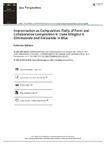Improvisation as Composition: Fixity of Form and Collaborative Composition in Duke Ellington's<i>Diminuendo and Crescendo in Blue</i>
| dc.contributor.author | Williams, Katherine | |
| dc.date.accessioned | 2016-03-24T19:00:00Z | |
| dc.date.available | 2016-03-24T19:00:00Z | |
| dc.date.issued | 2012-08 | |
| dc.identifier.issn | 1749-4060 | |
| dc.identifier.issn | 1749-4079 | |
| dc.identifier.uri | http://hdl.handle.net/10026.1/4428 | |
| dc.description.abstract |
Since the beginning of Duke Ellington's career as composer and leader of his own jazz orchestra in the 1920s, a common critical theme has been the comparison with European art music composers such as Delius and Debussy. Assertions such as Constant Lambert's 1934 statement that Duke Ellington set a standard by which we may judge. highbrow composers focused on the complex compositional devices in his output. Rather than restate these oft-cited judgements of Ellington's compositional style, this paper examines the intersection between the classical and jazz styles by analyzing typically improvised sections of Ellington's output. Consideration of the development of a baritone saxophone solo, improvised material in the interlude, and the role of Ellington's piano in three recordings of his 1937 Diminuendo and Crescendo in Blue (from 1937, 1953 and 1956) indicate the establishment of fixed solos in the Ellington Orchestra's repertoire. The degree of composition implied by this warrants further thought. Through analysis of Ellington's original sketches for the piece, close study of these recordings, and engagement with contemporary criticism and later scholarly sources (in particular the writings of Bruno Nettl) I evaluate the implications of the predetermination suggested by the treatment of improvisation by Ellington and his band members over this period. © 2012 Taylor & Francis Group, LLC. | |
| dc.format.extent | 223-246 | |
| dc.language | en | |
| dc.language.iso | en | |
| dc.publisher | Informa UK Limited | |
| dc.title | Improvisation as Composition: Fixity of Form and Collaborative Composition in Duke Ellington's<i>Diminuendo and Crescendo in Blue</i> | |
| dc.type | journal-article | |
| dc.type | Journal Article | |
| plymouth.issue | 1-2 | |
| plymouth.volume | 6 | |
| plymouth.publication-status | Published | |
| plymouth.journal | Jazz Perspectives | |
| dc.identifier.doi | 10.1080/17494060.2012.729712 | |
| plymouth.organisational-group | /Plymouth | |
| plymouth.organisational-group | /Plymouth/Faculty of Arts, Humanities and Business | |
| plymouth.organisational-group | /Plymouth/REF 2021 Researchers by UoA | |
| plymouth.organisational-group | /Plymouth/REF 2021 Researchers by UoA/UoA33 Music, Drama, Dance, Performing Arts, Film and Screen Studies | |
| dc.identifier.eissn | 1749-4079 | |
| dc.rights.embargoperiod | Not known | |
| rioxxterms.versionofrecord | 10.1080/17494060.2012.729712 | |
| rioxxterms.licenseref.uri | http://www.rioxx.net/licenses/all-rights-reserved | |
| rioxxterms.type | Journal Article/Review |


